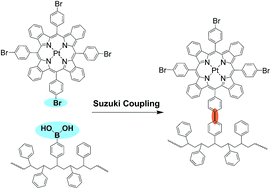Robust optical oxygen sensors based on polymer-bound NIR-emitting platinum(ii)–benzoporphyrins†
Abstract
Several advanced optical oxygen sensor materials are presented. They are based on bright NIR-emitting platinum(II)–benzoporphyrins covalently incorporated into a variety of polymeric matrices. The dye–polymer conjugates are prepared either via Suzuki coupling of the brominated porphyrins to the styrene backbone or via co-polymerisation of the monomers with monostyryl porphyrin derivative. Importantly, in both strategies a highly stable C–C bond is obtained. The resulted materials benefit from excellent photophysical properties of the benzoporphyrin dyes (high brightness, emission in the NIR part of the spectrum) and high stability of the covalently grafted materials due to complete suppression of dye migration and leaching. This is demonstrated to be particularly important for operation of the sensors in harsh conditions e.g. during steam sterilization where the materials based on non-covalently grafted dyes showed significant drift of their calibration. Additionally, we present a new synthetic method for preparation of analytically pure benzoporphyrins via simple 1-step template condensation which a promising alternative to the commonly used Lindsey method.


 Please wait while we load your content...
Please wait while we load your content...